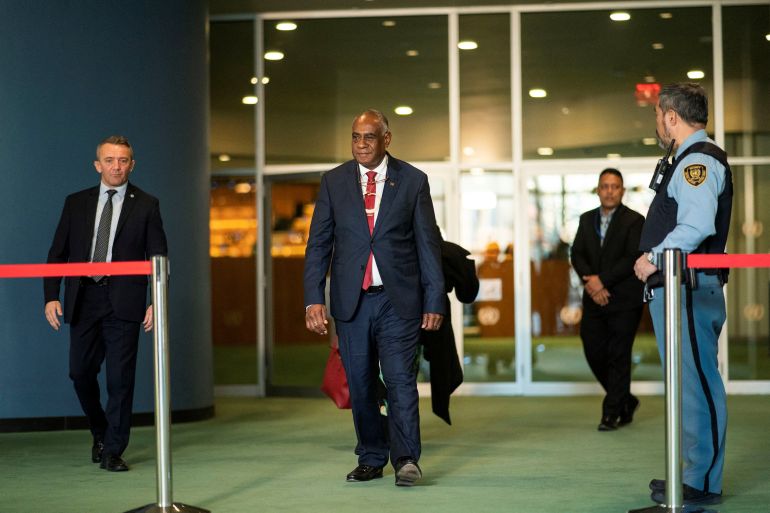As attacks on Christians become more frequent, a crisis looms for Israel
Church leaders point to inhospitable political atmosphere as they lock compounds at night; government ministries insist they are actively combating ill-treatment
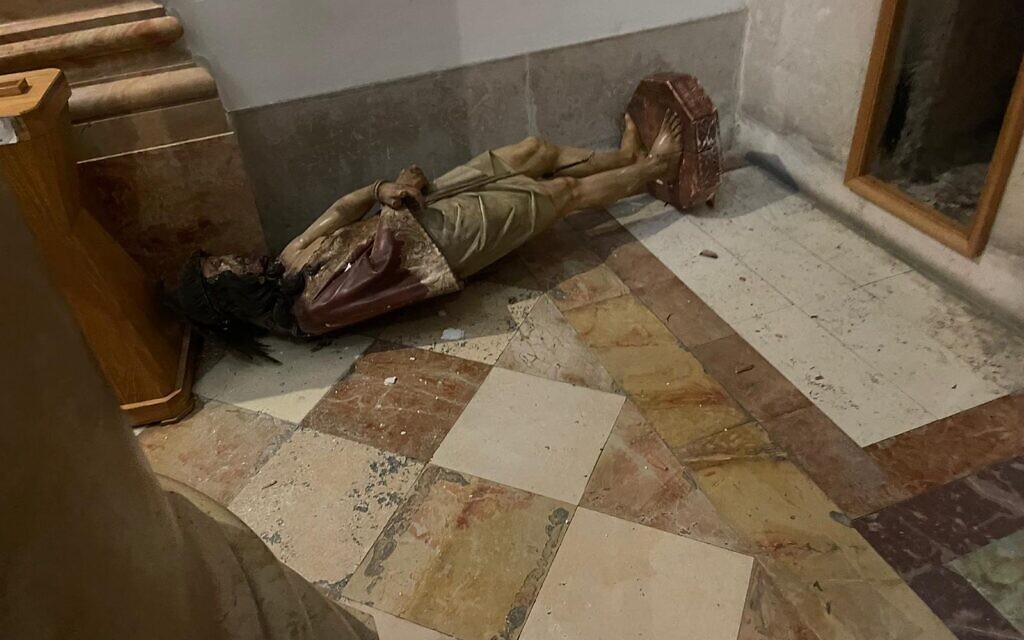 A toppled statue in the Church of the Flagellation, in the Old City of Jerusalem, February 2, 2023. (Custody of the Holy Land)
A toppled statue in the Church of the Flagellation, in the Old City of Jerusalem, February 2, 2023. (Custody of the Holy Land)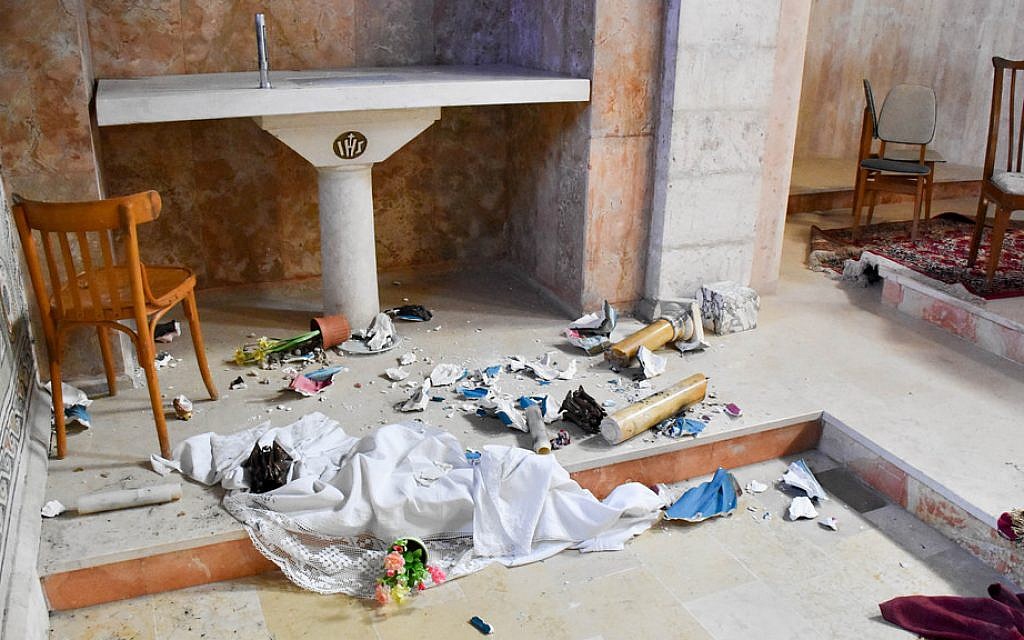 The vandalized sanctuary of the Beit Jamal Monastery seen on September 22, 2017. (Latin Patriarchate of Jerusalem)
The vandalized sanctuary of the Beit Jamal Monastery seen on September 22, 2017. (Latin Patriarchate of Jerusalem)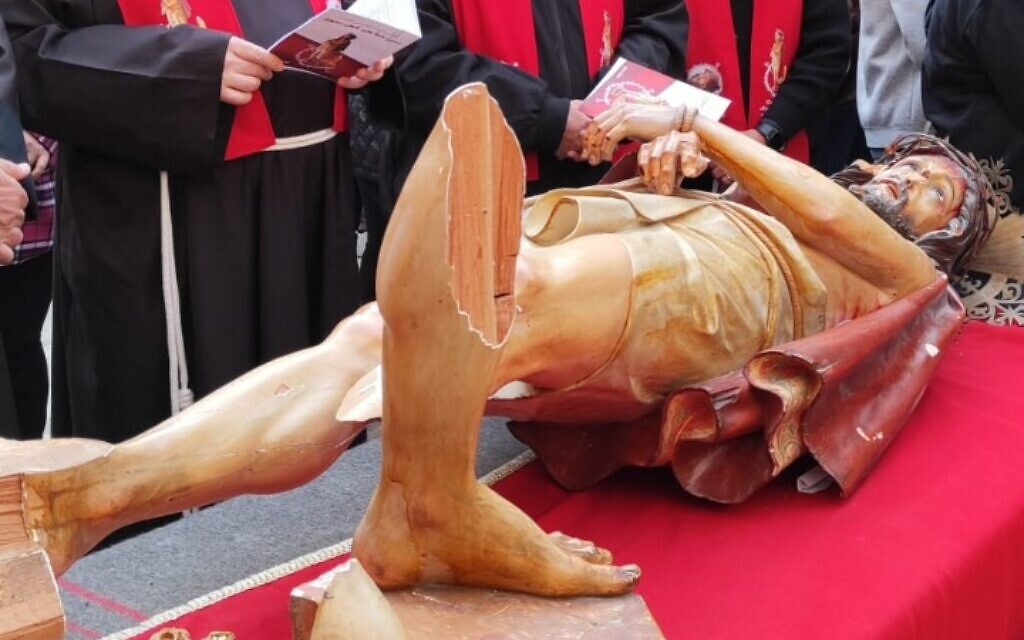
Catholic leaders, including Custos Francesco Patton (L), stand around a- vandalized statue of Jesus, March 24, 2023 (Filippo De Grazia)
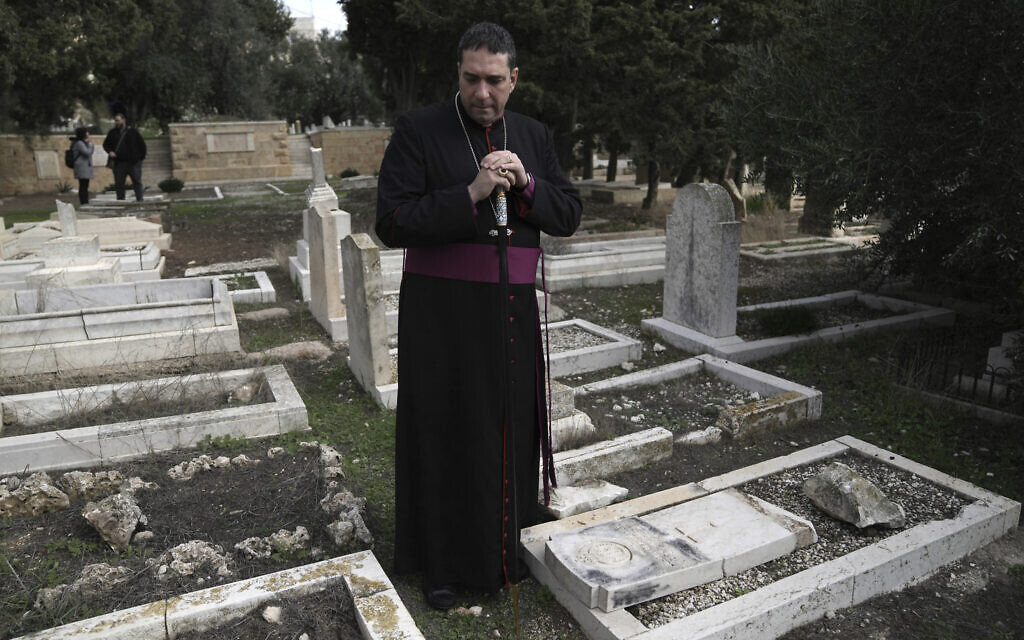
Hosam Naoum, a Palestinian Anglican bishop, pauses where vandals - desecrated more than 30 graves at a historic Protestant Cemetery on
- Jerusalem's Mount Zion in Jerusalem, January 4, 2023. (AP Photo/ Mahmoud Illean)
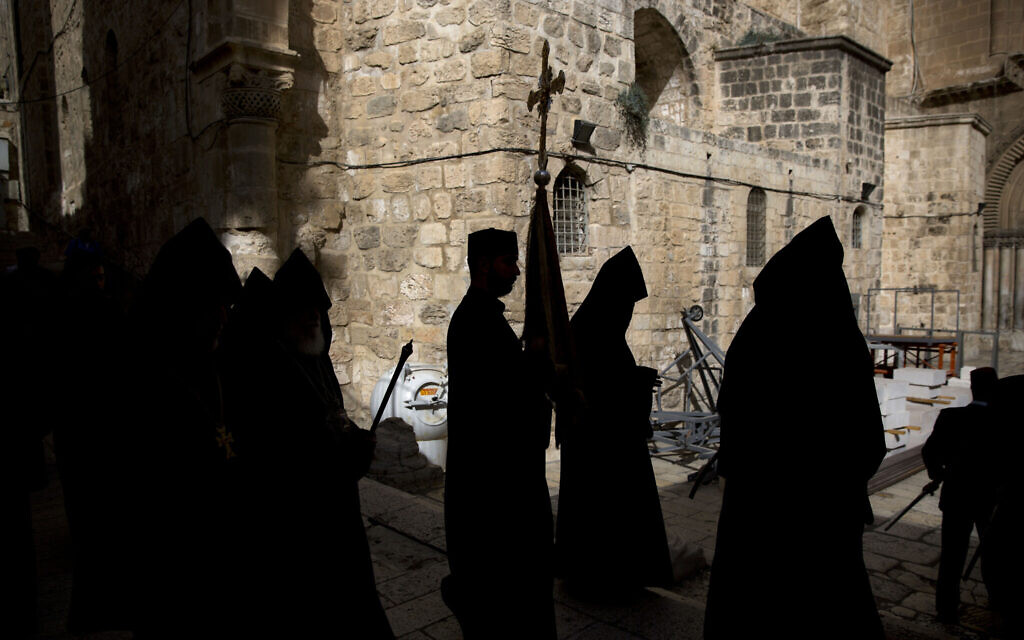
Illustrative -- In this Oct. 9, 2016 photo, Armenian priests arrive for - Sunday mass at the Church of the Holy Sepulchre during its renovation
- in Jerusalem's Old City (AP Photo/Oded Balilty)
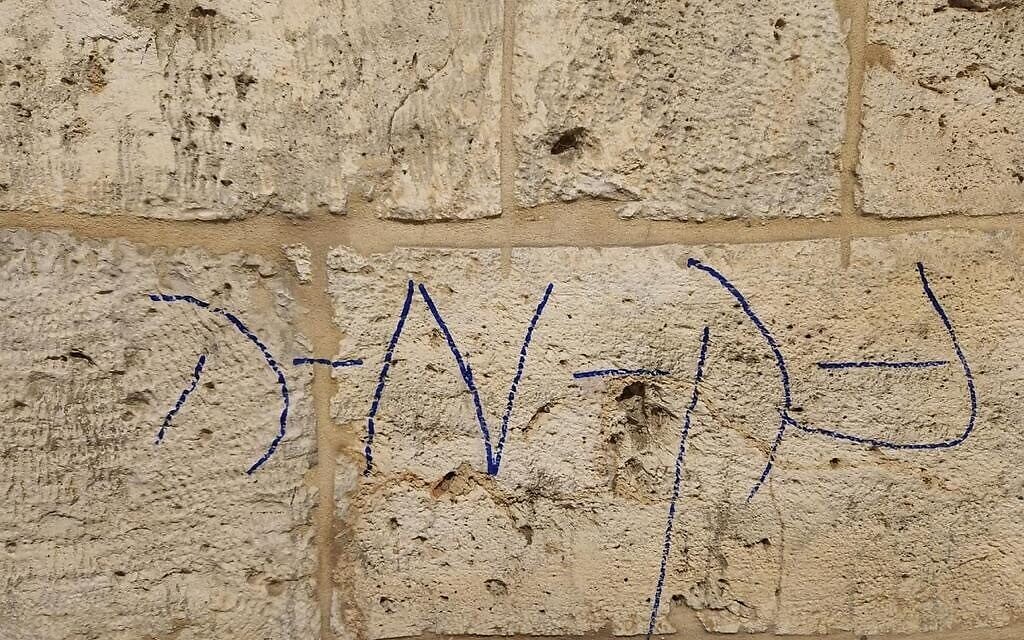
The word 'revenge' is graffitied in Hebrew on a wall in the Armenian - Quarter of Jerusalem's Old City, January 11, 2022. (Armenian Patriarchate)1
“If you are a Christian in the Middle East, there’s only one place where you are safe,” asserted Prime Minister Benjamin Netanyahu, speaking to Christian Zionists in Rio de Janeiro in December 2018. “There’s only one place where the Christian community is growing, thriving, prospering. That’s in the State of Israel.”
Netanyahu’s claim is a central element of the image Israeli officials put forward about the country when speaking to Western audiences.
Ahead of Christmas last year, Israel’s official Twitter account posted a video of the Foreign Ministry’s Digital Diplomacy chief David Saranga on a “magical Christmas stroll” through Jerusalem’s Old City.
The picture of safe coexistence painted by Israeli officials is starkly at odds with the experiences Jerusalem’s Christian leaders themselves describe. While they readily acknowledge that there is no organized or governmental effort against them, Christian clergy in the Old City tell of a deteriorating atmosphere of harassment, apathy from authorities, and a growing fear that incidents of spitting and vandalism could turn into something far darker.
And with Netanyahu already under scrutiny from Western allies over policies toward the Palestinians and attempts at sweeping judicial reform, deteriorating safety for Christians — or at least Church leaders disseminating that narrative — could become another serious diplomatic problem for Israel’s embattled government.
March of the schoolchildren
On Friday, hundreds of Catholic schoolchildren in Jerusalem embarked on their traditional march along the Via Dolorosa as they do every year during the 40 days of Lent.
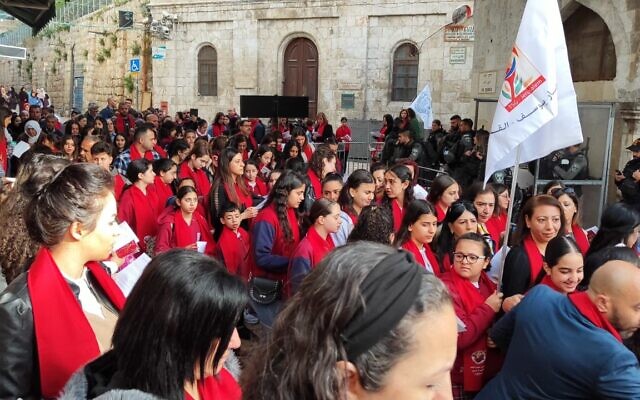
This time was different, however.
The students set off from the Church of the Flagellation, the second station of the cross, all clad in identical red scarves that bore the image of a broken statue of Jesus, the Scourged Savior effigy vandalized by an American Jewish tourist in the church in February.
The march, joined by the two senior Catholic figures in the Holy Land — Patriarch Pierbattista Pizzaballa and Custodian of the Holy Land Francesco Patton — was not limited to a protest against that one incident.
“We are horrified and hurt in the wake of the many incidents of violence and hatred that have taken place recently against the Catholic community in Israel,” said Patton, also known as the Custos.
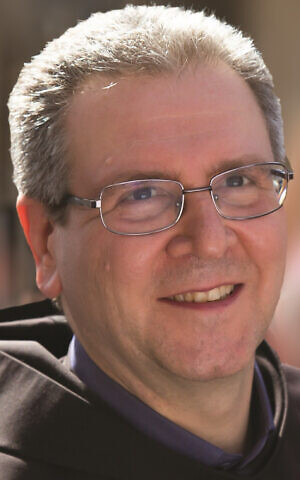
He cited seven incidents that have taken place in recent weeks, saying pointedly that “it is no coincidence that these serious incidents are taking place specifically now.”
“We expect and demand from the Israeli government and law enforcement to act with determination to stamp these serious phenomena.”
While there have long been periodic incidents of vandalism and harassment against Christian clergy in Jerusalem’s Old City, there has been a noticeable rise in attacks in recent weeks.
In November, two soldiers from the Israel Defense Forces’ Givati Brigade were detained on suspicion of spitting at the Armenian archbishop and other pilgrims during a procession in the Old City.
In early January, two Jewish teens were arrested for damaging graves at the Protestant cemetery on Mount Zion.
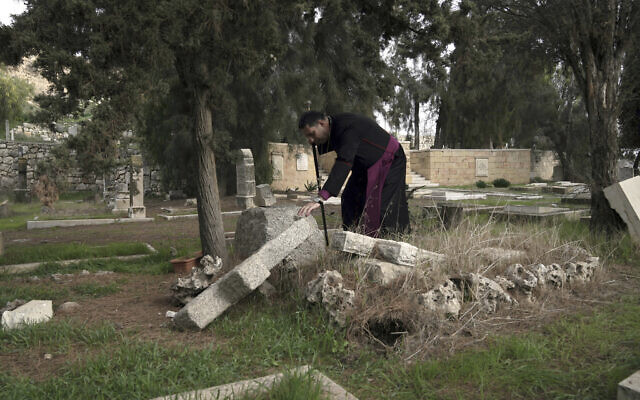
The next week, the Maronite community center in the northern city of Ma’alot-Tarshiha was vandalized by unknown assailants over the Christmas holiday.
Jerusalem’s Armenian community buildings were also targeted by vandals, with multiple discriminatory phrases graffitied on the exterior of structures in the Armenian Quarter. According to the Armenian Patriarchate, “revenge,” “death to Christians,” “death to Arabs and gentiles” and “death to Armenians” were all graffitied in the quarter.
The attacks kept coming. On a Thursday night in late January, a gang of religious Jewish teens threw chairs at an Armenian restaurant inside the city’s New Gate. The vandalism at the Church of the Flagellation occurred the very next week.
And last week, a resident of southern Israel was arrested after attacking priests with an iron bar at the Tomb of the Virgin Mary in Gethsemane.
“Terrorist attacks, by radical Israeli groups, targeting churches, cemeteries, and Christian properties… have become almost a daily occurrence that evidently increases in intensity during Christian holidays,” said the Greek Orthodox Church.
And not all incidents even make the news. Father Matthew, secretary to the Greek Orthodox Patriarch Theophilus III, told The Times of Israel that last Tuesday, a handicapped priest making his way slowly out of the Greek Orthodox monastery was spat on by two religious Jewish youths. When another priest confronted the assailants, they pulled up their shirts to show canisters of pepper spray.
According to Father Matthew, the police detained, then released, the attackers.
Jerusalem Police told The Times of Israel it was not familiar with the incident, and asked for additional details.
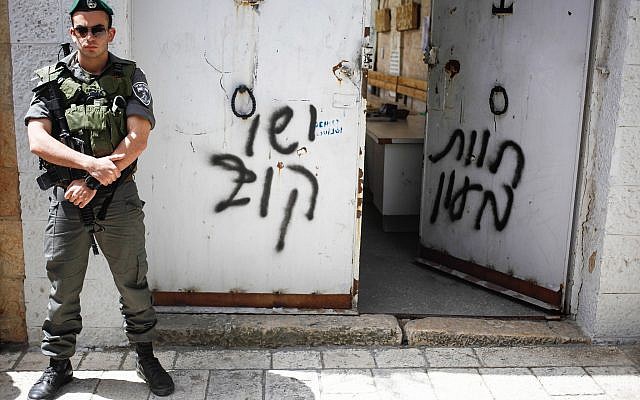
Church officials are critical of the overall police response.
“The police try to paint each attack as something isolated, and try to paint the attackers as mentally unstable,” said Amir Dan, spokesman for the Franciscan Custody of the Holy Land. “In doing so, the police remove themselves from all responsibility.”
Indeed, after the Church of the Flagellation attack, police said they were checking whether the suspect had mental health issues. Police told The Times of Israel that the attacker at Mary’s Tomb — a Christian Moldovan-Israeli — was committed to a mental hospital temporarily.
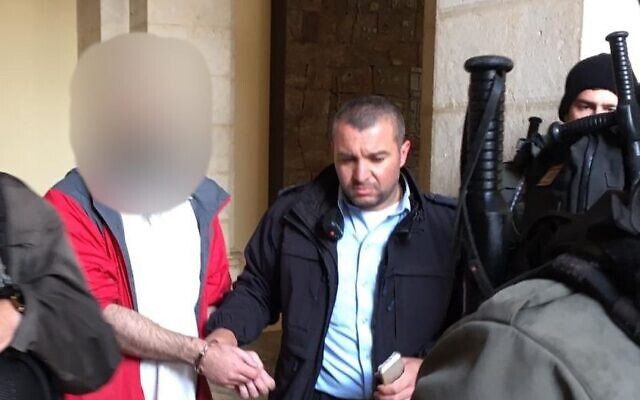
The Franciscans in the Old City are so worried that they have been locking the doors to their San Salvatore compound in the Old City at night ever since the desecration of the Jesus statue. They have never taken such a measure in the past, said Father Alberto Pari, secretary of the Custody
“I think all the Christians, they are more aware that someone can enter and do something,” said Pari.
The police try to paint each attack as something isolated, and try to paint the attackers as mentally unstable.
Multiple officials repeated the charge that the rise in attacks is connected to the current ruling coalition, which includes far-right figures like National Security Minister Itamar Ben Gvir.
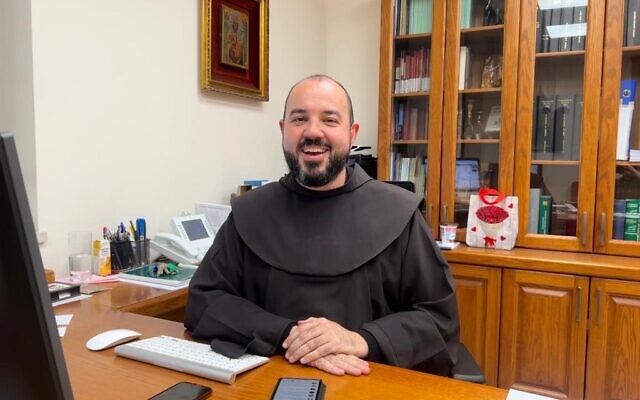
“Because of the government situation, some extremists, they feel like they have a protector,” said Pari. “Nobody will stop them if they do something that maybe they were thinking to do also before. But then there was more control from the police or they were not supported by some political leaders.”
Dan concurred with Pari’s assessment: “Unfortunately after this government was elected, there are those who feel they can do whatever they want. That they can lift up their fists and nothing will happen to them.”
Concerned ministries
The Israeli bodies in touch with Israel’s churches all condemn the attacks and insist they are aware of the problem.
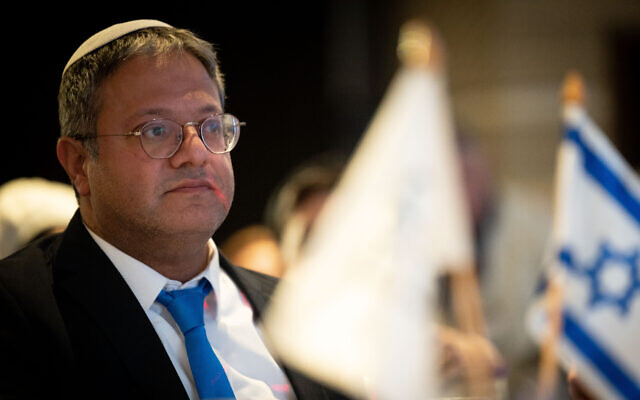
“We are very attentive,” said Tania Berg-Rafaeli, director of the Foreign Ministry’s World Religions Department.
She said her office called the Greek Patriarchate after the attack at Mary’s Tomb to express solidarity and condemn the attack, as it regularly does.
“These attacks aren’t representative of Israeli society,” she said.
The Interior Ministry told The Times of Israel that its Religious Communities Department is in close touch with the Custody of the Holy Land, recently visited Patriarch Pizzaballa and the Protestant Cemetery, and is involved in dealing with the spitting incidents and the attacks in the north.
“The Interior Ministry, through the Religious Communities Department, works continuously through a guiding ethic of providing freedom of religion and worship, and protecting the Status Quo and Holy Places, and is present at all times to help and assist as much as possible, and hopes that violent incidents will end immediately,” the ministry spokesperson said in a statement.
The ministry added that the personal safety of Israel’s residents is the responsibility of the police.
The police stressed to The Times of Israel that they arrested the Mary’s Tomb attacker before he could cause any damage or injuries. They interrogated the 27-year-old and brought him to court to extend his custody.
“We view with severity all kinds of violence,” said the police in a statement, “and will continue to act against acts of violence in general, and specifically violence in holy places, with a heavy hand without compromise on the goal of bringing offenders to justice.”
Jerusalem Deputy Mayor Fleur Hassan-Nahoum has led the attempts to get a handle on the situation on the municipal level.
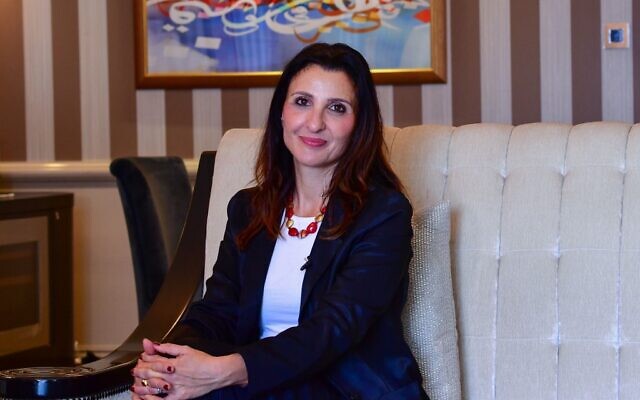
“We have become increasingly more aware of the situation,” Hassan-Nahoum told The Times of Israel. “In my hat as both tourism and international relations head, I have been gathering all the different stakeholders to talk about solutions.”
The Times of Israel viewed the minutes from a meeting Hassan-Nahoum chaired in December, in which city councilmembers, police, and representatives from Old City NGOs sought to address the attacks.
Tammy Lavi of the Jerusalem Intercultural Center told the forum that at least 50% of the Friday Armenian processions are interrupted by spitting, cursing, or people intentionally walking through the ceremony.
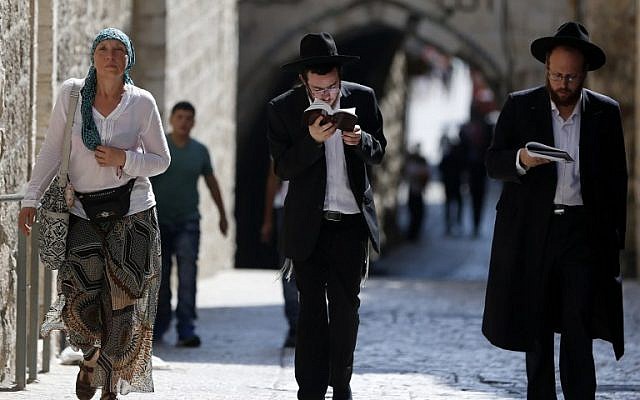
The attendees placed much of the blame on the “Zilbermans,” members of a 300-family-strong Lithuanian ultra-Orthodox community in the Old City that distinguishes itself from other Haredi communities with their unique approach to Torah study that includes right-wing Zionist ideas.
In the municipality meeting, right-wing city councilor Yehonatan Yosef agreed to go with deputy mayor and activist Aryeh King to speak with the Zilberman rabbis about stopping their students from harassing Christian tourists and ceremonies.
Rhetorical tax
Though violence has risen of late, church leaders in Israel were sounding the alarm well before the current government came to power. But many Israeli officials feel that the churches often go too far, paying a sort of rhetorical tax to the Palestinian Authority every year at Israel’s expense to ensure the well-being of their Palestinian congregants.
What’s more, though the heads of many churches are often European, the congregations and priests are primarily Palestinian, and the local churches are suffused with Palestinian liberation theology. In this school, Zionist Jews play the part of oppressive Romans, and Palestinians are identified with Jesus. Old and persistent tropes of Jewish deicide and supersessionism are regular features of Palestinian church rhetoric.
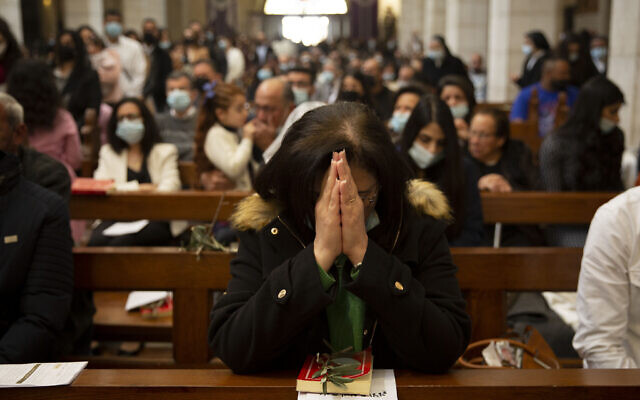
A 2021 joint statement ahead of Christmas by “the Patriarchs and Heads of Churches in Jerusalem” warning that radical Jewish groups were working to drive Christians out of Jerusalem was met with indignant fury by the Foreign Ministry headed by Yair Lapid, and by President Isaac Herzog, neither of whom could be called right-wing extremists.
An Israeli statement said that the Church leaders’ accusations “are baseless, and distort the reality of the Christian community in Israel.”
“The statement by Church leaders in Jerusalem is particularly infuriating given their silence on the plight of many Christian communities in the Middle East suffering from discrimination and persecution,” the statement continued.
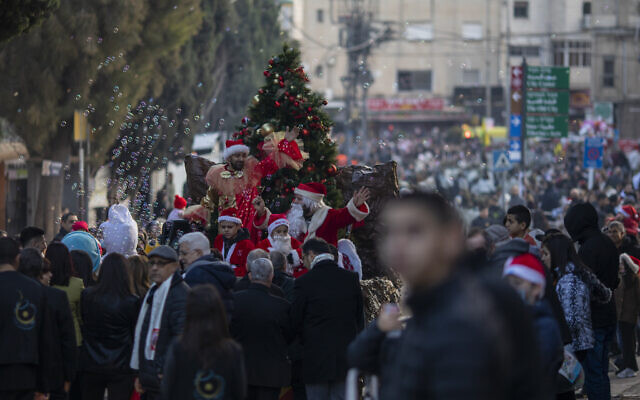
Days later, the Central Bureau of Statistics released a report stating that Israel’s Christian community grew by 1.4 percent in 2020 and numbers some 182,000 people, with 84% saying they were satisfied with life in the country. The statistics revealed that Arab Christian women had some of the highest education rates in the country.
Another looming crisis
The involvement of multiple Israeli ministries and offices in ensuring the welfare of the country’s Christian communities is a sign of an inherent problem. Since no one office is ultimately responsible for the file, Israeli policy is usually piecemeal and reactive. Problems often fall between the cracks until a crisis breaks out, forcing senior officials to put out fires.
In 2018, the heads of the Catholic, Greek Orthodox, and Armenian churches stepped up to a bank of microphones in front of the Holy Sepulchre Church, and accused the Jerusalem municipality of a “systematic campaign against the churches and the Christian community in the Holy Land.
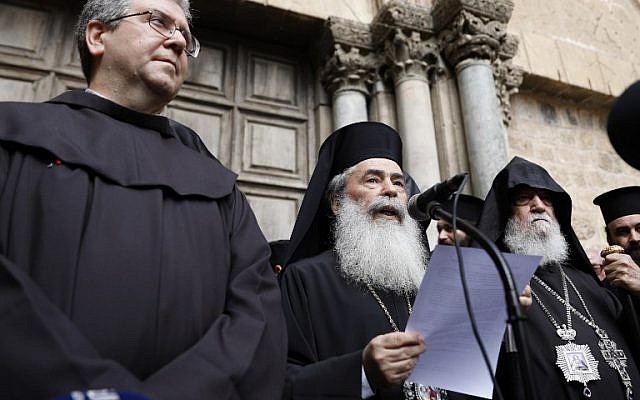
Theophilus then delivered the dagger: “This reminds us all of laws of a similar nature which were enacted against the Jews during dark periods in Europe.”
The Church elders gathered in front of their holiest site after they discovered that the Knesset was set to discuss — and in all probability pass — a bill that day allowing the state to confiscate land sold by the churches to private investors. It was also motivated by a recent decision by the Jerusalem Municipality to freeze churches’ assets until they cough up millions of shekels in what the city claims are unpaid taxes.
The point made, the Palestinian keeper entrusted with the church’s keys climbed up a ladder and locked the ancient doors. They would stay closed for three days, until Netanyahu intervened, suspending the tax collection and freezing the legislation until a newly formed committee — to be headed by then-regional cooperation minister Tzachi Hanegbi — could work out the issues with the churches.
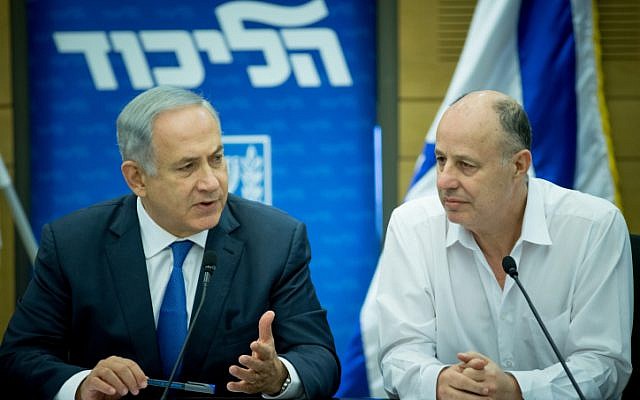
But the damage was already done. Netanyahu’s involvement only came after Israel buckled under heavy pressure from the Vatican, Orthodox countries like Russia and Greece, and Evangelical Christian groups that are staunch supporters of Israel.
It seems Israeli policy-making is no more forward-thinking today. Days after the Church of Flagellation attack, the Jerusalem municipality demanded that the Vatican-owned Notre Dame of Jerusalem Center pay overdue city property taxes of NIS 18 million ($5 million), placing a lien on the institution’s bank accounts until it settles the payment.
It was the latest product of Israel’s long-standing refusal to view its relationship with the Christian world as a distinct policy issue that demands dedicated staff and attention from senior officials.
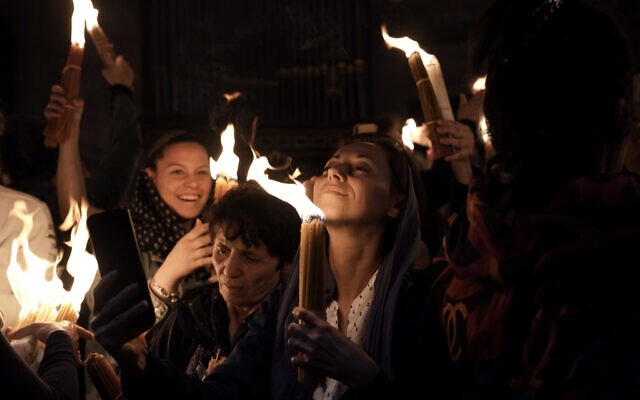
If Netanyahu doesn’t start treating the tax fight and the safety of Christian clerics and pilgrims as issues that demand holistic solutions led by his government, he could soon find himself under even more pressure from Israel’s most important allies. Those same Western countries have not hidden their discomfort over the proposed judicial reform and statements from the coalition’s right wing.
“The Vatican, and the ambassadors of Italy, Spain, France, Greece, Belgium and the United States are regularly updated on the events,” said the Franciscan Custody’s Dan of the attacks and vandalism. “All of them are following the situation with great concern.”
But there isn’t much optimism among Christian clergy in Jerusalem that the situation is going to get better anytime soon.
“Nothing is going to change,” predicted Father Matthew ominously, “until someone gets killed.”
TIMES OF ISRAEL

